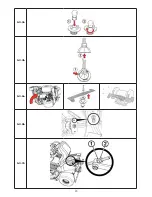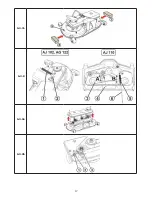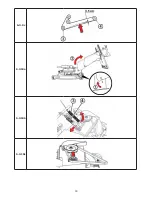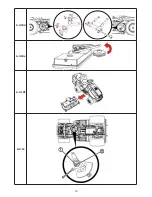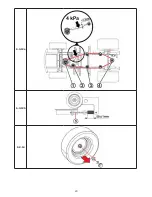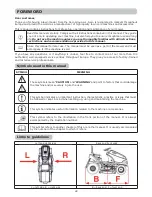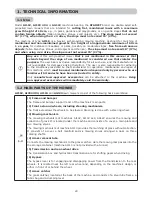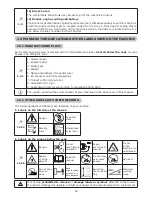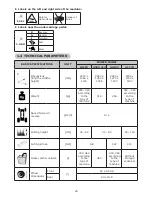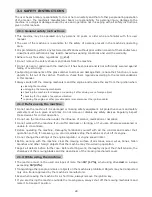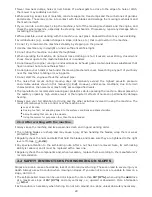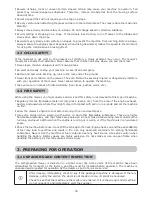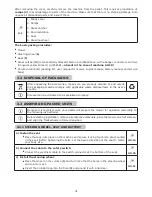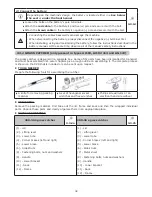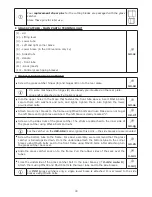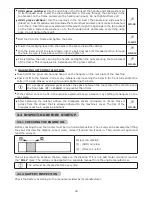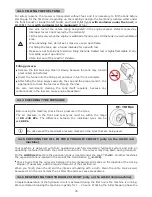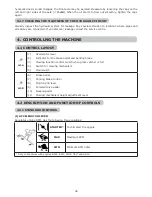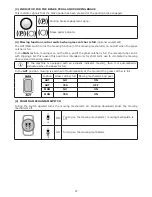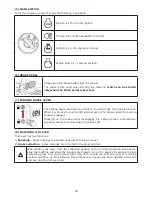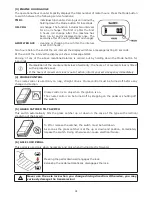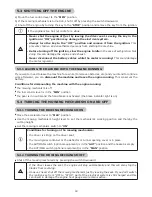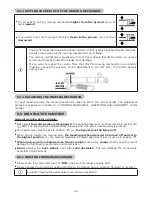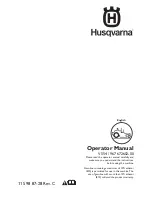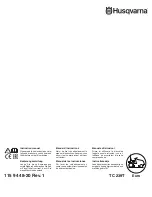
29
!
Never mow near dumps, holes or river banks. If a wheel gets too close to the edge of a hole or ditch,
the mower may suddenly overturn.
!
While working, keep clear of molehills, concrete supports, tree stumps and the curb stones of gardens
and streets. These may come into contact with the blades and damage the mowing mechanism and
the machine itself.
!
If you run into a solid object, stop the machine, shut off the mowing mechanism and the engine, and
check the whole machine, especially the steering mechanism. If necessary, repair any damage before
restarting the machine.
!
Where possible, avoid working with the machine on wet grass. Reduced traction may cause skidding.
!
Avoid obstacles (e.g., sudden changes in slope, ditches, etc.) that could overturn the machine.
!
Do not try to maintain the machine’s stability by stepping on the ground.
!
Use the machine only in daylight or under sufficient artificial light.
!
Do not drive the machine on public thoroughfares.
!
When operating the machine, do not wear loose clothing or short trousers; wear strong, closed work
shoes. Never operate the machine barefoot or in sandals.
!
Do not leave the engine running in enclosed spaces. Exhaust gases contain poisonous substances that
have no odour but are nonetheless fatal.
!
Do not place your hands or feet under the mowing mechanism cover. Never bring any part of your body
near the machine’s rotating or moving parts.
!
Do not start the engine without the exhaust pipe.
!
The noise that occurs during mowing does not ordinarily exceed the highest acoustic pressure
and volume values shown in this manual (
1.4
). However, under some conditions, due to terrain
characteristics, the noise level may briefly exceed specified levels.
!
The manufacturer recommends wearing ear protectors while operating the machine. Stress placed on
the auditory organs by high volume levels or the long-term effects of noise can permanently damage
hearing.
!
Always give your full attention to driving and the other activities involved in using the machine. The
most common ways to lose control over the machine are:
Loss of traction.
Driving too fast; not adapting speed to the surface conditions and characteristics.
Abrupt braking that can lock the wheels.
Using the mower for purposes other than those intended.
2.1.4 After working with the machine
!
Always keep the machine and its accessories clean and in good working order.
!
The rotating blades are sharp and may cause injury. When handling the blades, wrap them or wear
protective gloves.
!
Regularly check the nuts and bolts that hold the blades, and make sure they are tightened to the right
level of torque (
6.3.6
).
!
Pay special attention to the self-locking nuts. After a nut has been removed twice, its self-locking
ability is reduced, and it must be replaced with a new one.
!
Regularly check the components and, when necessary, replace them according to the manufacturer’s
recommendation.
2.2 SAFETY INSTRUCTIONS FOR WORKING ON SLOPES
Slopes are a main cause of accidents, loss of control and overturning. These can lead to severe injury or
death. Always use extra caution when mowing on slopes. If you are not sure or are unable to mow on a
slope, don’t do it.
!
The self-propelled mower can be used on slopes of no more than
10° (17%)
, when using the
4x4
drive
at a maximum slope of
15° (27%)
and only vertically, i.e., upward or downward. More information
5.5.4
.
!
Extra caution is necessary when turning. Do not turn around on a slope unless absolutely necessary.
Summary of Contents for EF106J Starjet
Page 2: ...2 1 2 1 3 1 1 3 2a ...
Page 3: ...3 1 3 2b 1 3 2c 1 3 2d ...
Page 4: ...4 3 1 3 3 1a 3 3 1b ...
Page 5: ...5 3 3 1c 3 3 1d 3 3 2a ...
Page 6: ...6 3 3 2b 3 3 2c 3 3 2d ...
Page 7: ...7 3 3 2e 3 3 2f 3 3 2g ...
Page 8: ...8 3 3 2h 3 3 2i ...
Page 9: ...9 3 3 2j 3 3 2k ...
Page 10: ...10 3 3 2l 3 3 2m 3 3 2n ...
Page 11: ...11 3 3 2o 3 4 5 ...
Page 12: ...12 3 4 6 4 1a ...
Page 13: ...13 4 1b 4 2 1a ...
Page 14: ...14 4 2 1b 5 6a 5 6b 6 2 2 ...
Page 15: ...15 6 3 3a 6 3 3b 6 3 6a 6 3 6b 6 3 7a ...
Page 16: ...16 6 3 7b 6 3 7c 6 3 7d ...
Page 17: ...17 6 3 7e 6 3 8 6 3 9a 6 3 9b ...
Page 18: ...18 6 3 9c 6 3 10a 6 3 10b 6 3 10c ...
Page 19: ...19 6 3 10d 6 3 10e 6 3 10f 6 3 11 ...
Page 20: ...20 6 3 12a 6 3 12b 6 3 14 ...
Page 21: ...21 6 4 ...
Page 341: ...341 ...
Page 342: ...342 ...
Page 343: ...343 ...

